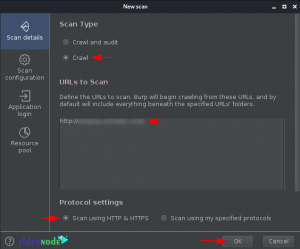
Burp suite scanner full#
Burp suite scanner free#
Business Logic Flaws: APIsec leverages the power of AI to deeply understand how your API works, making it possible to uncover business logic vulnerabilities - one of the most dangerous types of cyberthreats that typically slip through the cracks.ĪPIsec offers a free API assessment that tests your endpoints and provides a report of the findings.API Pen Tests: APIsec simulates attacks on your API, ensuring its every aspect is secure from potential hacks.Automatic Testing: The scanners run continuous, comprehensive tests that cover a wide range of vulnerabilities, including the OWASP Security Top 10 list.Full Coverage: APIsec learns the ins and outs of your API once it is integrated into your system, discovering exactly how it is used and where weaknesses may occur.It identifies loopholes regardless of the size and complexity of your API, including business logic flaws (an aspect other scanners often overlook that allows hackers to abuse the legitimate functionalities of your API) before hackers have the chance to exploit them. APIsec is the only AI-based solution that writes tests for you, allowing you to fully automate the entire API security testing process. Most API security testing tools require you to manually write thousands of test cases. Create a config.xml with the targetSitemap (typically, the base URL of the application), scope, exclusions, false-positives etc.APIsec is a vulnerability scanner that offers full coverage API scanning and automated testing designed to keep up with your fast-paced business.Run the functional/integration tests against the target.Configure your functional/integration tests to go through the burp proxy (defaults to 4646 if you use the extension) by setting HTTP_PROXY or similar.This is where the "seed" data for scanning is going to be stored. Follow instructions at Headless Burp Proxy and start up burp proxy and remember to set the -project-file option.The Headless Burp Proxy extension provides an simple way to achieve this. To handle such cases, it would be best to let the burp proxy intercept some real traffic to the target and build up a sitemap for itself.

This way, it can attack the target URLs more effectively and potentially discover more than a shot in the dark spider + scan approach. when scanning a web application where routing is handled using JavaScript.īurp scans can discover more if it can scan more "real-world" requests and responses. Sometimes, just spidering a target scope and and performing on a scope of URLs doesnt give much value.įor e.g. Scenario D: Scan more than just GET requests - Use request.response data derived from running functional/integration tests as input to the scan ¶ You can find more details about Issue Definitions here Add a false-positives block with the issue type and path (these can be retrieved from a burp scan report) to the configuration file.Scenario C: Scan URL(s) for security issues using Burp but suppress false positives from the scan report ¶ Create a file - config.xml like below and add the URL(s) to be scanned to the scope.The extension has been designed to be versatile and support several scenarios Scenario A: Scan URL(s) for security issues using Burp ¶ auto-repair Automatically repair a corrupted project file specified by the -project-file option user-config-file=VAL Load the specified user configuration file(s) this option may be repeated to load multiple files config-file=VAL Load the specified project configuration file(s) this option may be repeated to load multiple files collaborator-config=VAL Specify Collaborator server configuration file defaults to nfig collaborator-server Run in Collaborator server mode use-defaults Start with default settings diagnostics Print diagnostic information p (-prompt) Indicates whether to prompt the user to confirm the shutdown (useful for debugging) c (-config) Configuration file (mandatory)

project-file=VAL Open the specified project file this will be created as a new project if the file does not exist (mandatory)


 0 kommentar(er)
0 kommentar(er)
